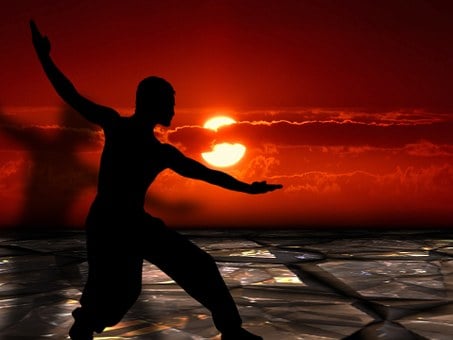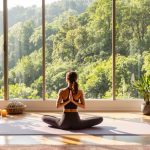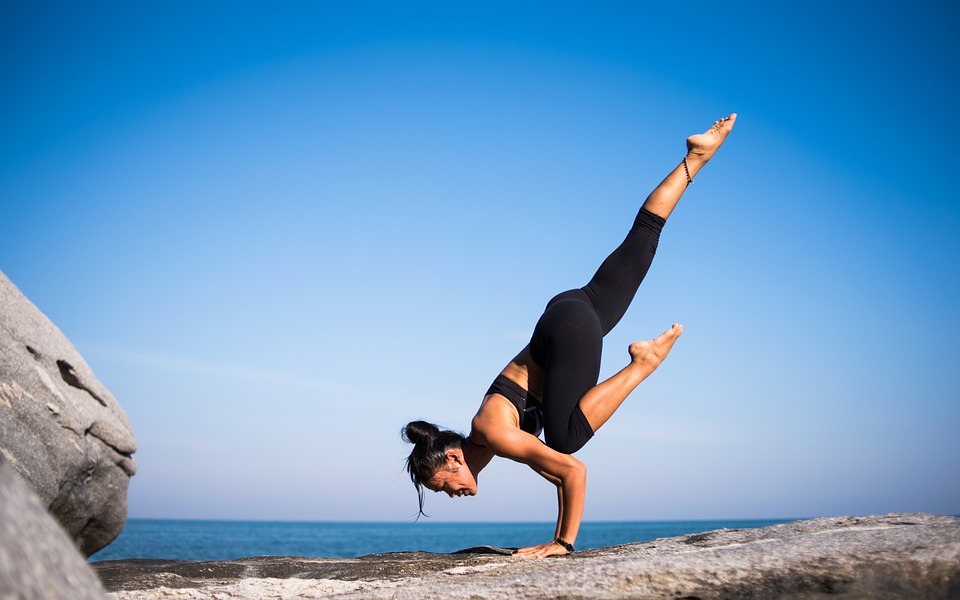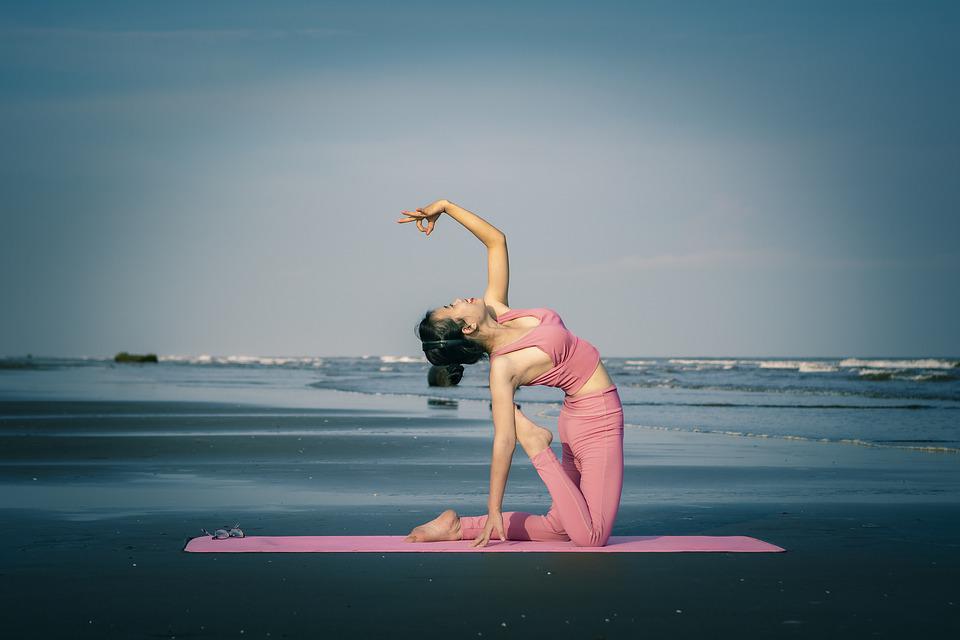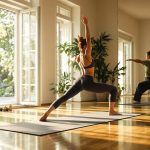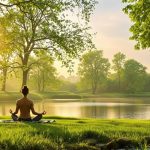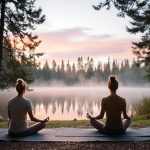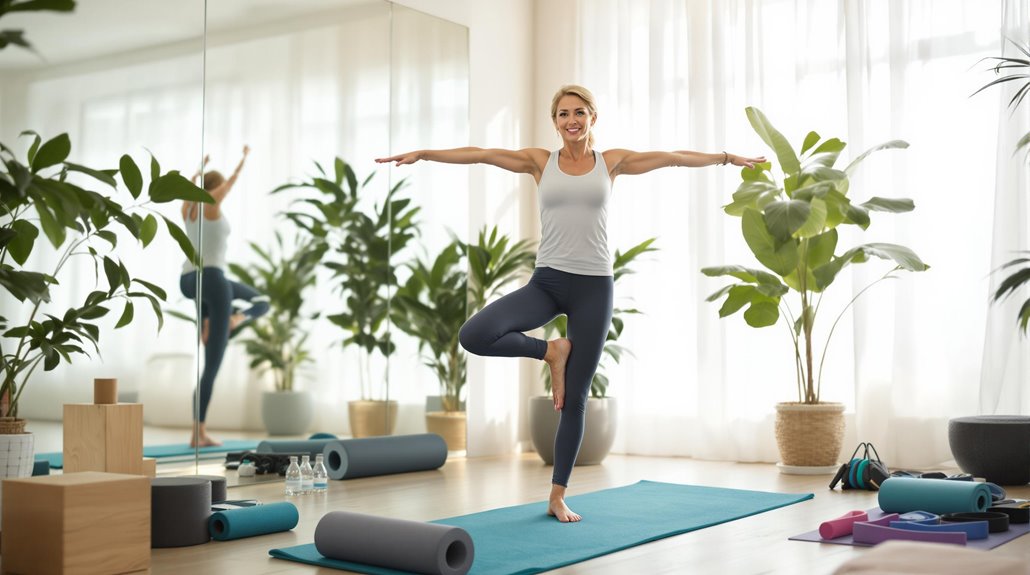
To enhance your flexibility and balance, try incorporating these seven exercises into your routine: Leg Swings improve lower body flexibility and joint health, while the Downward Dog to Plank shift boosts core strength and stability. Warrior II Pose dynamics and Tai Chi Cloud Hands foster muscle flexibility and mindfulness. Standing on one leg strengthens your core and lower body, and Heel to Toe Walks train balance and proprioception. Finally, the Flying High Plank challenges your core stability and body alignment. Each exercise not only enhances performance but also reduces injury risks. Discover how these moves transform your physical capabilities.
Leg Swings for Flexibility
How do you effortlessly boost your flexibility and warm up your lower body before exercise? Incorporating leg swings into your dynamic warm-up is your answer.
Avoid bending your back or rotating your hips, allowing a full range of motion.
Explore various types such as forward leg swings, focusing on hip flexors and hamstrings, and lateral leg swings targeting the sides of your hips. You can even try linear straight and bent leg swings for added glute and hamstring stretch.
Integrate these into your workout routine at the start of a lower-body session or during any pre-run warm-up. Aim for 10 to 20 reps, boosting performance and minimizing injury risk.
Downward Dog to Plank
As you shift from Downward Dog to Plank, you’re engaging your core muscles, boosting both strength and endurance. Focus on moving with control to challenge your balance and improve your stability. This dynamic shift not only strengthens your abs and back but also enhances your overall flexibility and coordination. Engaging the core throughout the movement helps to stabilize the body and prevent injury. This transition contributes to improved performance in various sports and fitness activities due to increased core strength.
Core Engagement Benefits
Core engagement in exercises like shifting from Downward Dog to Plank ignites a symphony of balance and stability. Imagine each move strengthening your core stability, essential for maintaining steadiness in dynamic movements. By engaging these muscles, you’re creating a foundation that helps prevent injuries.
With a concentrated core, you’re not just enhancing your physical equilibrium but actively reducing the risk of falls and other mishaps. It’s more than just exercise; it’s about ensuring you move through life with ease and agility.
A strong core acts like an athletic powerhouse, enabling you to transfer force between your upper and lower body with finesse. Whether you’re swinging a golf club or sprinting on a track, an engaged core minimizes fatigue, amplifies endurance, and refines athletic performance.
It’s not just about sports—it’s about improving the quality of every movement you make.
Moreover, your core is the unsung hero in preventing injuries and alleviating pain. By stabilizing and supporting the spine, core strength diminishes the risk of lower back pain and other muscle strains.
With stronger core muscles, you protect yourself from overuse injuries while enhancing flexibility in every joint.
Transitioning With Control
Strengthening your core forms the foundation of achieving fluidity and control in exercises like moving from Downward Dog to Plank. This dynamic movement demands a harmonious balance between strength and grace. You start in Downward Dog, lifting your hips high, creating a powerful upside-down V-shape with intention. Engaging your core, you press your palms firmly into the ground, providing stability. As you inhale, let the energy guide your hips forward, shifting into Plank with a controlled change. Feel the shift as your shoulders align over your wrists, your body a straight line from head to heels, grounded yet liberated.
| Essential Cue | Feeling of Freedom |
|---|---|
| Engage the core | Radiate confidence |
| Breath focus | Create inner peace |
| Controlled flow | Embrace liberation |
| Neutral spine | Express strength |
Inhale deeply, ground your toes, and squeeze the glutes, taking command of your own movement. Your changes are smooth and purposeful, avoiding any jerky rhythms. As you exhale, let your hips glide back into Downward Dog, embodying freedom with every motion. Experiment with variations, like toe taps or Three-Legged Dog, to elevate your practice. With each controlled change, you release the boundless potential within yourself.
Warrior II Transition
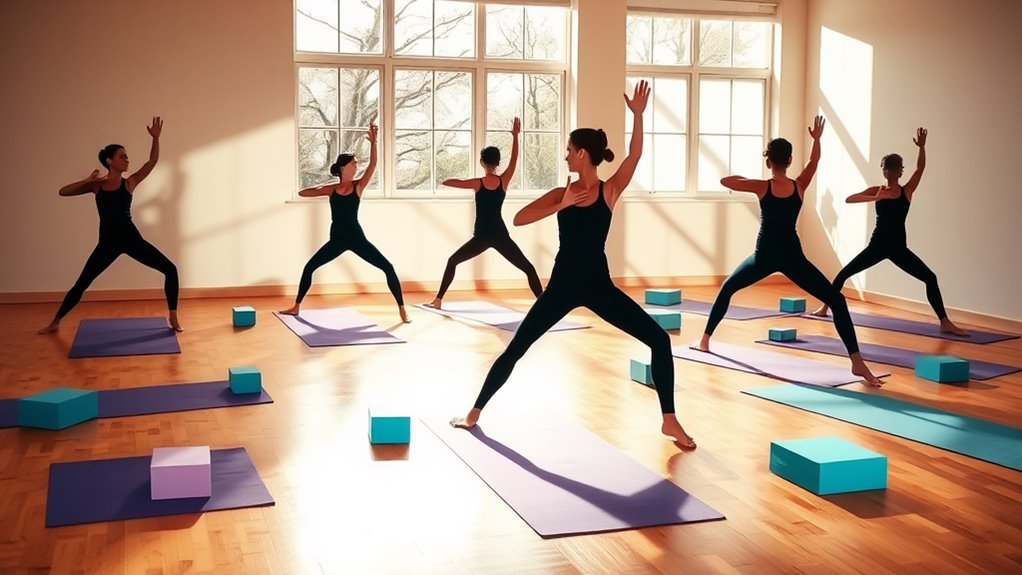
When shifting into Warrior II, you’ll engage your core and maintain balance by aligning your body properly. This pose not only enhances stability but also improves muscle flexibility as you extend your arms and support your body weight. Incorporating dynamic flows like moving from Downward-Facing Dog to Warrior II can further boost your flexibility and balance, creating a strong, fluid practice. A low-impact exercise like Pilates helps improve spinal health by focusing on core strength and posture, which is crucial for maintaining balance in poses like Warrior II.
Enhancing Balance Stability
Achieving balance stability in Warrior II shifts hinges on precise foot alignment and stability. Begin by directing your front foot straight forward, perfectly aligned with the center of your mat. This simple yet profound yoga posture taps into balance techniques that foster gentle, proprioceptive training.
Turn your back foot inward at a 45-degree angle, grounding through its outer edge. Align your front heel with the arch of the back foot to distribute weight evenly, a vital alignment awareness practice. Press through the four corners of both feet, firming your legs in solidarity with stability exercises that liberate you from wavering.
Bring your hips into play, opening them toward the mat’s long edge to maintain dynamic movement without tilt. Stack your bent front knee directly over its ankle while your front thigh angles toward parallel, cultivating core stability.
Stay mindful of your spine, letting it lengthen as your shoulders relax. Extend your arms dynamically, palms facing down, promoting both stability and grace. Draw your lower abdomen in, anchoring your tailbone as mindful breathing invigorates your core.
Use Ujjayi Pranayama to enhance your experience. As you shift, relish the flow, staying present for 5-6 breaths to deepen your newfound balance.
Improving Muscle Flexibility
Enhancing your sense of balance in Warrior II naturally leads to opening up opportunities for greater muscle flexibility. As you explore dynamic stretching and mobility drills, the shift possibilities within the Warrior II sequence become a pathway to liberation.
One significant set of shifts serves to stretch different muscle groups thoroughly:
- Reverse Warrior Shift: Start in Warrior II, then lower your back arm to your back leg while reaching your front arm toward the ceiling. This stretches your side body, opening up your chest and enhancing your flexibility.
- Extended Side Angle Shift: From Warrior II, bring your front hand to the mat or a block and extend your opposite arm overhead. It’s essential to keep your front knee bent. This shift strengthens legs while enhancing torso flexibility and keeping shoulders relaxed.
- Half Moon Pose Shift: By shifting weight onto your front leg and lifting your back leg, you’ll engage your glutes and increase hip mobility. Stack your hips and keep the lifted foot’s inner arch aligned with the standing foot’s heel.
With these shifts, you not only enhance flexibility but also empower your movements, embracing strength with grace.
Tai Chi Cloud Hands
Among the various practices that enhance flexibility and balance, Tai Chi Cloud Hands stands out as a unique exercise that harmonizes the mind, body, and breath into a coordinated rhythm.
With its core rooted in Tai Chi, this movement embodies mindfulness techniques that free you from everyday stress. By focusing on a rhythmic dance of hands, waist, and feet, you improve coordination, gracefully glide into a state of calm, and ease tension from your shoulders and neck.
Dive into the flowing motion of this exercise by mastering the double arm silk reeling movement. Your hands and arms will mimic the gentle weaving motion of a silk worm as you step to the side.
Let your waist guide the movement, anchoring strength in your core while softening your knees and hips. This deliberate weight shift frees you from being “double weighted,” enhancing your sense of balance and ease.
Different styles, like Yang, Chen, and Sun, offer variations in arm orientation and body posture, yet all emphasize relaxed shoulders and rotating torso movements.
Embrace the freedom as you explore these styles, feeling each motion synchronize seamlessly with your breath, guiding you toward liberation. Regular practice of Tai Chi has been shown to increase muscle strength and improve overall physical performance.
Stand on One Leg
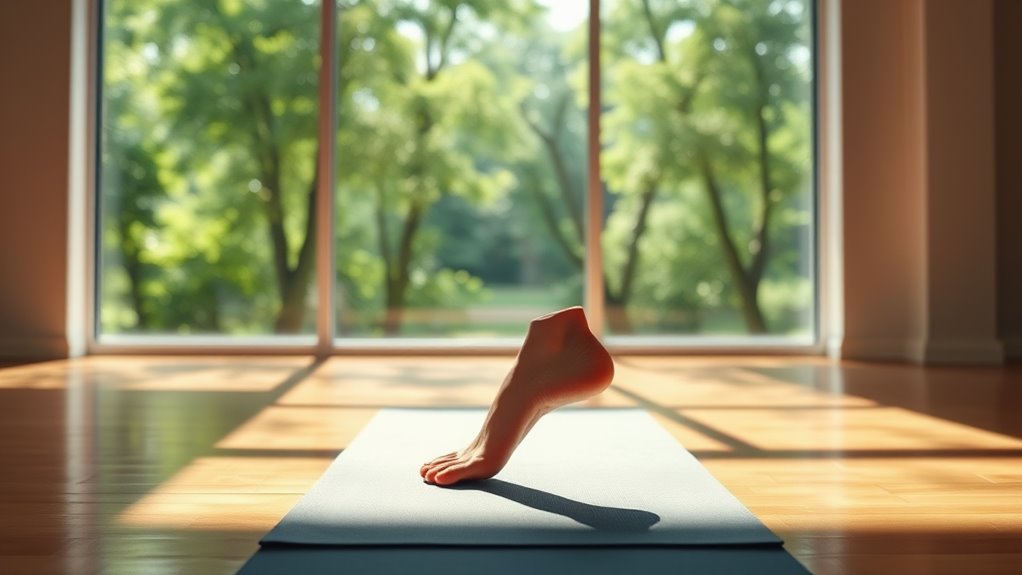
Standing on one leg might seem simple, yet it offers a wealth of physical and cognitive benefits that make it a valuable exercise for people of all ages.
It’s not just about balance challenges; this exercise strengthens your core, hips, and lower body, including those critical abdominal muscles.
With single-leg variations, you’ll also enhance ankle and foot stability, reducing joint-related issues like arthritis.
Plus, your brain gets a workout too, as it stimulates the cerebellum, boosting coordination and cognitive function.
Incorporating exercise into your routine can also alleviate anxiety symptoms, promoting overall mental resilience and well-being.
Here’s how you can incorporate it into your life and elevate your sense of freedom:
- Daily Tasks: Balance while brushing your teeth or cooking to seamlessly integrate this exercise without extra time.
- Static to Dynamic: Begin by standing on one leg for 30 seconds near support. Progress to dynamic balance with tasks like marching or stepping over obstacles.
- Routine Consistency: Aim for at least three times a week to maximize benefits, complementing your other physical activities.
Heel To Toe Walk
Mastering the Heel To Toe Walk is a simple yet powerful way to boost your balance and stability. Imagine walking with confidence, knowing each step is a stride toward freedom. This gait training exercise enhances your proprioception and strengthens key muscles in your ankles and feet. By adopting these balance techniques, you’ll not only prevent falls but also move through life with greater ease and assurance.
To perform the Heel To Toe Walk, stand tall on a firm surface next to a wall or chair, providing support if needed. Focus on your posture, engaging your core and relaxing your shoulders. As you step, place your heel directly in front of your toes, maintaining a deliberate pace. Look forward, using your peripheral vision to stay aware of your surroundings.
Over time, increase distance and experiment with backward walking or holding a weighted ball for an added challenge. This practice mimics natural human movement, making it both mechanically and physiologically economical. It activates your calves, quadriceps, and glutes while conserving energy—vital for longer walks.
Flying High Plank
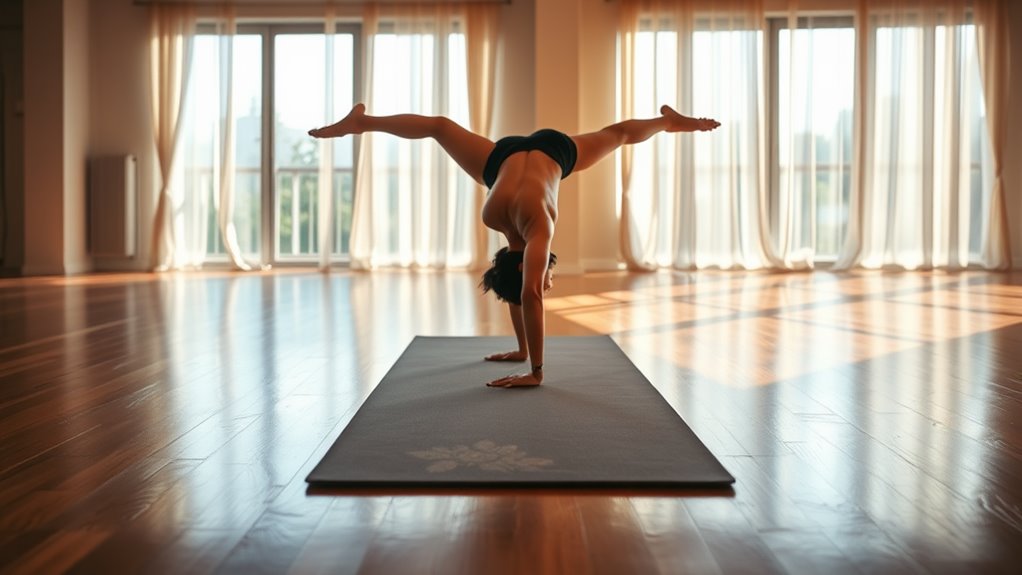
As you advance in your balance journey, let’s explore the Flying High Plank, an exercise that challenges not just your core but also your overall body stability. This plank variation is a powerful tool for core strengthening, offering new heights in flexibility and balance.
Here’s how you can embrace this liberating workout:
- Setup and Positioning: Plant your hands shoulder-width apart and extend your feet behind, maintaining a straight line from head to heels. The core, glutes, and quads should be engaged for ideal balance.
- Engagement and Alignment: Activate your core and glutes to keep the body aligned. Tighten your abs to protect your spine and flatten your belly while stretching your heels back.
- Execution and Safety: Begin with dynamic movements, like shifting to a forearm or side plank variation, and plank hops for added intensity. Aim for three steady sets, keeping your hips from swaying to maintain form.
It’s all about freedom of movement while engaging the entire body. Prioritize form to avoid injury and maximize strength.
Adjust your foot width as needed for stability, using these plank variations to release new dimensions of physical prowess and self-expression.


